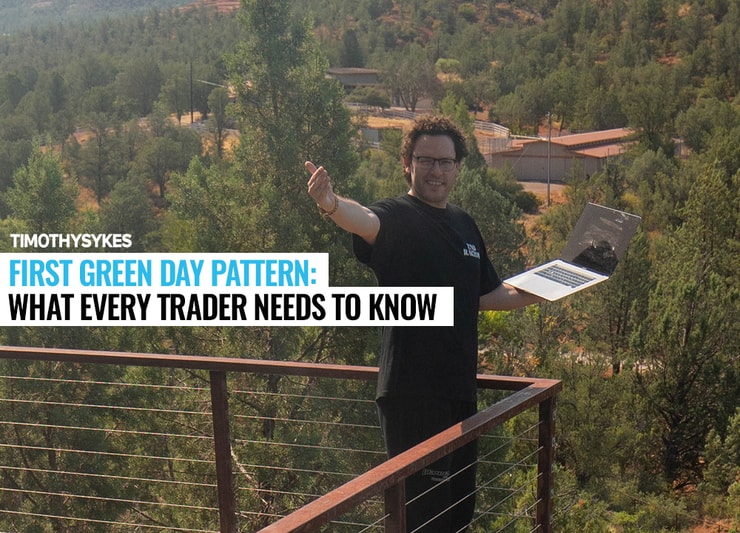The first green day pattern is one of my all-time favorite trading patterns. I think every trader should know it and understand how to use it.
It can be a great pattern for new traders, especially if you have a small account and are under the pattern day trader rule (PDT).

But the first green day doesn’t mean just any old green candle on the chart. And that confuses a lot of new traders about what this pattern actually is and what to look for…
So, in this post, I’m digging into what is a green day in stocks, how you can find them, and how to trade a first green day…
Let’s do this!
Table of Contents
- 1 What Is a Green Day in Stocks?
- 2 What Is the First Green Day Pattern?
- 3 First Green Day Pattern vs. First Red Day Pattern
- 4 How Can You Take Advantage of the First Green Day Pattern
- 5 How to Trade First Green Day Stocks in 3 Steps
- 6 First Green Day OTCs: What Should You Do Differently
- 7 How to Manage the Risks of Trading First Green Day Stocks
- 8 Conclusion: Is There a Right Way to Trade First Green Day Stocks?
What Is a Green Day in Stocks?
A green day in stocks refers to the color of the candlestick.
When a stock closes at a higher price than it opened, it creates a green candlestick on the chart. If a stock closes at a lower price than it opened, it creates a red candlestick.
Because I’m a long-biased trader, I want to see green candles on a chart. I want the price to be increasing so I can buy low and sell high.

What Is the First Green Day Pattern?
The first green day pattern is a big green candle on the daily chart after a stock has been beaten down or stuck in consolidation.
It happens when a low-priced stock announces good news. A new product, earnings, a new investor, positive trial results if it’s a biotech stock, even new 52-week highs — those can all be positive catalysts that get traders interested in the stock.
The positive news should bring high volume into the stock. I like to see more volume than it would trade on an average day. This tells me the news has the attention of traders.
I also want it to be a big percent gainer. Big percent gainers with high volume get a lot of attention. They show up on more and more traders’ scans — even traders who don’t normally look at penny stocks.
More volume and interest can mean bigger, more volatile price moves.
New to penny stocks? Get started with my free online guide.
First Green Day Pattern vs. First Red Day Pattern
The first green day is a pattern for long-biased traders. The first red day pattern is ideal for short-sellers.
I only recommend short-selling for more experienced traders. More on the risks of shorting later…
But if you’re a short seller, the first red day pattern can offer better risk/reward than trying to short the first green day.
A first red day pattern shows up when a stock has multiple green candles on the daily chart, then one day the stock opens lower than the previous close…
It’s the first time long traders have to worry — a gap down and a red candle can indicate a trend reversal.
Long traders can start to take profits and short sellers may start pressuring the stock, causing the price to go down. As it goes down, it can start triggering stop-loss orders, which creates even more selling. All that means a price drop and a red candle on the daily chart.
As for why I don’t short sell much and don’t recommend it for new traders…
It’s way too risky and an overcrowded strategy. A lot of the big moves we’ve seen lately are short squeezes due to overaggressive short sellers. These kinds of traders short anything that’s up. They think it’s a junk penny stock and it has to go down. Most of the time they’re not wrong … but too early.
I also don’t short stocks because I trade with a small account. I’m focused on teaching new traders the right patterns, mindset, and habits to help them stay in the market long term.
If you don’t know what you’re doing, short seller. SureTrader was good at finding shares to short. But when they stopped being good for short selling can be a good way to blow up your account FAST!

How Can You Take Advantage of the First Green Day Pattern
There are a few ways you can take advantage of the first green day pattern…
I don’t consider a stock a first green day pattern until it’s closing near its daily high. I want to make sure the stock is gonna hold its highs through the day.
That means I usually end up trading a stock multiple times before I know if I want an overnight position.
If I see a stock in the morning with news, high volume, and a catalyst, I might dip buy a morning spike or buy intraday breakouts. But that doesn’t mean I hold all day. I make quick trades in and out. Not all stocks with new and volume will hold up.
Better to expect the worst so you’re not disappointed.
At the end of the day, I’ll watch to see if a stock is closing strong before I make a plan for an overnight hold. And holding overnight is what’s so great about his pattern … If you’re under the PDT, it doesn’t use a day trade. And ideally, you take advantage of a gap up the next morning.
Want to build your education foundation but unsure where to start? My 30-Day Bootcamp can get you started in the right direction.
It’s a month’s worth of lessons with daily assignments and homework. You can complete it at your own pace and repeat it as many times as you need. It also comes with “The Complete Penny Stock Course” book and my “Pennystocking Framework” DVD. You get all three for under $100!
How to Trade First Green Day Stocks in 3 Steps
Before you trade the first green day pattern, here’s what you need to know. First…
Find the Right Stocks for the First Green Day Pattern
Want to know how to find first green day stocks? I use StocksToTrade.
I use its stock screener every morning to find the biggest percent gainers with news and high volume.
StocksToTrade has 40+ built-in scanners, built-in watchlists, news, and social media feeds — everything you need to find stocks to day trade. You can also customize your searches and use one of its many tools to help you research and plan your trades.
Get a 14-day trial of StocksToTrade for only $7. Or get it with the Breaking News Chat for only $17!
(I’m an investor in StocksToTrade and helped design it to fit the penny stocks I love to trade.)
Once you have a list of stocks from your scan, it’s time to…

Research and Study Charts With the First Green Day Pattern
You have to find out why the stocks on your list are big percent gainers. Research the company, dig up any news, and study the charts for patterns. (Again, you can do this all on StocksToTrade.)
Ideally, you should do your scan and research before the market opens. But you can run scans again midday to find any movers that you might have missed in the morning. Then when it comes time to take a position before the close, you’re armed with all the information and your trading plan…
More Breaking News
- Canopy Growth’s Latest Moves: Are Shares Set to Take Off or Crash?
- Tevogen Bio Shares Skyrocket Amid Promising Revenue Projections and Clinical Trials
- NuZee Shares Skyrocket: What Triggered the 740% Surge in Stock Prices?
Buy Before the Close
Like a sniper, watch and wait for your entry. I prefer to buy dips before the close to get a position. It offers me a better risk/reward if a stock fails before the close and I have to cut losses.
Once I have a first green day pattern position, I watch to make sure the stock closes strong. If it does, I hold overnight with a goal to sell in the morning into a gap up and maybe a morning spike.
But if the stock looks weak, I get out. If it starts rallying before the close and makes new highs, I sell into the strength. Or, if I’m trading a listed stock and it makes a big move after hours, I can sell into a spike.
First Green Day OTCs: What Should You Do Differently
One of the biggest differences between a first green day pattern on a listed stock and a first green day OTC is that OTC stocks don’t trade in after-hours or premarket.
This means that anyone who missed the news on day one puts their orders in first thing the next morning. All the orders sitting there creates a bigger gap up.
The first green day OTC is one of my favorite patterns to trade. It allows me to take advantage of the informational inefficiencies in penny stocks.
I trade this pattern often, but I don’t always have to hold it overnight. Like I said before, I sometimes sell before the close if I don’t like the price action or if my profit goals for the trade are met. I don’t get greedy and hold overnight if I don’t have to.
Check out all of my trades on Profit.ly. I post them to be transparent in this industry full of fakes and liars. It also allows my students to learn from my trades. Use them to understand why I take the trades that I do, and my ideas behind the trades.

How to Manage the Risks of Trading First Green Day Stocks
All trading is risky — no pattern works 100% of the time. The first green day pattern is no exception. So never risk more than you can afford to lose.
And always have a risk management strategy that works for you. Whether it’s a max loss per trade, a percentage of your account per trade, or a level on the chart — it doesn’t matter. Just have an exit plan and stick to it.
Cutting losses quickly is my rule #1. It’s how can you prevent a small loss from turning into a huge disaster.
If I hold a stock overnight and it gaps down the next morning, I’m out right away. I don’t give it any time. Sure, it could dip and come back, but it could also drop and turn into a morning panic. I don’t want to take that chance. Especially in this volatile market.
Get my no-cost “Volatility Survival Guide” for lessons on how to navigate this insane market volatility.
Conclusion: Is There a Right Way to Trade First Green Day Stocks?
I teach my students simple patterns to help them learn the nuances of the market. The first green day pattern is one of my favorites and a good place for new traders to start.
Don’t worry about trying to trade perfectly. My students and I aren’t perfect traders. We don’t catch the exact bottom and top — we take the meat of the move. And we’re meticulous about having a plan, sticking to it, and cutting losses if a trade goes against us.
So if you’re missing big moves or cutting losses only to have the stock reverse and do what you thought, don’t feel bad…
I almost always sell too soon. But my account grows over time because I cut losses quickly and keep my losses smaller than my gains.*
If you want to learn how I do it, apply for my Trading Challenge. If you’re accepted, you’ll get access to all my DVDs, over 6,000 video lessons on trading patterns, and weekly live trading and Q&A webinars. Plus, you’ll join a like-minded community of traders in my Challenge chat room.
What do you think of the first green day pattern? Do you love it as much as I do? Let me know in the comments … I love to hear from you!
(*Please note: My results are far from typical. Individual results will vary. Most traders lose money. I have the benefit of years of hard work, dedication, and experience. Trading is inherently risky. Do your due diligence and never risk more than you can afford to lose.)





Leave a reply